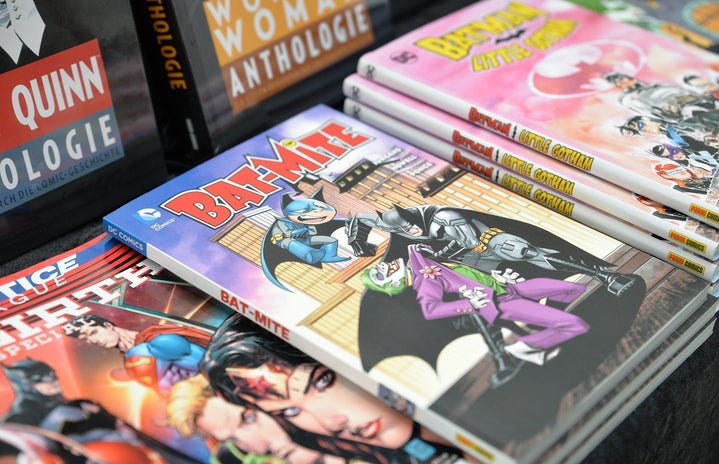At some point in your life, you may have had a phase when you were super into reading comics, and you may still be into it these days. We could never go wrong with classic superheroes like those of Marvel and DC. And, of course, there have been many iconic mangas published in Japan, such as “One Piece” and “Dragon Ball.”
When I was younger, all the comics I read were in the form of printed books. Since I did not use the Internet as frequently as I do now, I didn’t mind physically carrying the comic books with me wherever I went. However, in today’s age, where almost all of us use our phones to access all sorts of media content, I began to bring physical comics less frequently and relied on my phone.
At first, this transition from physical to digital was an act of peer pressure. I didn’t want to be the only person in the world carrying a comic book with her in public as a way to spend my free time.
But I slowly began to realize that it’s actually much easier to bring my phone rather than a book. Not only do I have a convenient way to communicate with others, but I can also easily access comics and other reading materials online.
Okay, let me back up a bit. These online “comics” may not exactly be what you’re thinking about, but there is actually quite a large selection of them that the typical “comics” fan may not have heard of. In fact, I personally consider them an excellent alternative for anyone who enjoys reading not just comics but anything in general.
A Crash Course on Webcomic History
The term “webcomic” originates from a German website in 1995, whose intent was to combine the words “Web” and “comic” into one. The first webcomic known to exist is “Doctor Fun,” which was a gag panel published in 1993 by David Farley. As the Web increasingly became a convenient and popular platform for creating all sorts of content, the year 1995 experienced a breakthrough in the emergence of webcomics. By the end of 1994, 3,000 websites for webcomics existed on the Web. In the next year, 20,000 additional websites were launched, leading to hundreds of new webcomics being posted on the Web. Webcomics “Kevin and Kell” (1995) and “Sabrina Online” (1996) have especially raised the bar by becoming two of the longest-running webcomics of all time.
In the late 1990s, many webcomic artists began experimenting with their art. They opened new genres, one of the most popular being the game-themed ones, phenomenally witnessed in works such as “Penny Arcade” (1998), created by Jerry Holkins and Mike Krahulik.
In 2000, American cartoonist Scott McCloud published the book Reinventing Comics, which explores many of the different perspectives and discoveries that have arisen from webcomics and digital art. In this book, he introduced a concept known as the “infinite canvas,” which entails that a Web page contains limitless space, providing artists the freedom to pace their art however they want.
Throughout the late 1990s and early 2000s, webcomics in the U.S. were especially soaring compared to their counterparts, mainly due to strong communities of readers and artists, such as Joey Manley, as well as the rise of the dot-com bubble.
Meanwhile, in South Korea, the comics industry underwent a major turning point in publishing history. In 1997, South Korea was hit by a major financial crisis known as the IMF (International Monetary Fund) Crisis, which caused people to only be able to rent comics instead of purchasing them. Then, in 1998, Korea concluded its censorship of Japanese media, which included manga (a powerful rival against Korean comics). Taking all these events into account, the industry of Korean comics (also known as manhwa) almost fell apart.
That was until more people turned to the Internet to buy and read comics. Kang Full and Snowcat were some of the most renowned artists at the time, paving the way for what the standard South Korean webcomic was to become in later years.
In the early 2000s, Korean web portal Daum launches Daum Comics World, which is considered the most successful webtoon platform of the 2000s. The first ever webtoon to have a long, scrollable format on Daum is “Love Story” (2003) by Kang Full.
It did not take long for Daum to face competition. In 2005, Daum’s rival, Naver, launched Naver Webtoon. This was headed as a passion project by founder JunKoo Kim, who envisioned creating a platform that would allow comics to be scrollable and, therefore, easy to read.
In the late 2000s, webtoons increasingly gained popularity as some of them were adapted into TV shows and films, while others were translated into multiple languages.
Ever since the release of the first iPhone in 2007, many readers began to read webcomics on their smartphones. This further mobilized the use of apps, the most popular of which is Line Webtoon. Around the same time, the increasing use of social media has led to artists posting their work on platforms such as Facebook and Instagram. Not only did this help many artists attract attention to their work, but it also gave some of them the opportunity to share their voice on social, political, and economic issues through art.
In 2011, artist Andrew Hussie published “Homestuck,” which set the stage for more narrative-based webcomics, as opposed to the short, single-panel gag strips.
Patreon, launched in 2013, became a vital source of income for many artists whose billing model supported long-running projects and provided a space for fans to monetarily support their favorite artists.
In 2014, both Naver and Daum made efforts to expand globally. Naver launched Line Webtoon worldwide, which allowed international artists to upload their work and readers from around the world to easily access webtoons. Daum merged with Kakao, the maker of South Korea’s top messaging service (Kakaotalk), to create a company that is worth $2.9 billion.
In the past few years, the efforts of webtoon platforms have only continued to take flight. “Solo Levelling” (2018), an action and fantasy-based web novel written by Chugong (and also a personal favorite of mine) became a global hit, reaching over 14 billion readers and earning a revenue of over $28 million. In 2019, “Love Alarm,” which is the first Netflix original to be based on a webtoon, was released. This is followed by subsequent releases that became fan favorites: “Itaewon Class,” “D.P,” “Sweet Home,” and “All of Us Are Dead.”
My Experience with Webcomics
The first time I discovered webcomics was back in 2013 when I came across a fan-made music video for “Ava’s Demon.” Since then, I would catch up on updates on “Ava’s Demon” from time to time. On top of that, I would regularly scroll through platforms like DeviantArt and Tumblr for fanart comic strips. A couple of years later, I naturally took a break from webcomics to explore other hobbies that I was interested in.
Just then, at the beginning of 2019, I received news that the company of BTS was planning to launch a webtoon titled “Save Me,” based on the storyline presented in many of their music videos.
As I scrolled through the episodes of “Save Me,” I instantly got hooked on the intense plot buildup and the captivating art. My curiosity got the best of me, and I began to check out other webtoons that would suit my interests.
One of the earliest webtoons that I immersed myself in besides “Save Me” was “True Beauty.” It is a romantic comedy about a girl named Jugyeong Lim, who enjoys wearing makeup to boost both her appearance and self-confidence. Little did I know that it would become a huge hit later on, as it became one of the most anticipated Korean drama adaptations in 2021, along with the webtoon itself reaching its finale after a total of 222 episodes.
Since I was occupied with a lot of things at the time, such as school, I barely had time to catch up with any other webtoon besides the two mentioned above.
Then came a time that probably nobody expected. Quarantine. From March 2020 onwards, I began using Webtoon as a way to both pass the time and calm myself down from all the chaos. I even remember telling one of my friends that Webtoon is “the one thing that keeps me sane at the moment.”
So in a way, the pandemic was a blessing in disguise. Over the course of ten months (March to December 2020), I have discovered and read a total of 20 webtoons.
Final Thoughts
Since the webtoons I have read vary in genre, it’s difficult to say whether I have a favorite webtoon genre. It is even more of a challenge to name my favorite webtoon. However, one thing I do know is that I have been able to gain a lot of knowledge about webtoons during this period, and if there was ever a profession known as “Webtoon Critic,” I certainly would’ve taken it.
In the present day, I am currently way more occupied than I was back in the quarantine period. Yet despite that, I have still managed to keep up with several ongoing webtoons that I discovered back in 2020. (And not to mention the events that let you win free coins to buy fast pass episodes.)
As someone who has been reading webtoons for almost four years, I think it is safe to say that I have pretty good judgment on which webtoons are worth reading. One of the biggest factors that help me determine a webtoon’s overall quality is whether it incorporates a variety of emotions, as opposed to just being 100% sad or 100% happy. The art style is a plus, but since I feel like it is subjective, I don’t really prioritize it in my evaluations.
As webcomics, namely webtoons, continue to flourish, it is only a matter of time before they emulate some of the most popular forms of today’s media entertainment. And as your so-called Webtoon Critic friend, I highly recommend that you try reading a webtoon or webcomic as soon as you can. I doubt that you’ll regret it, or at the very least, I know you will gain some inspiration from it.
Additional Sources
https://www.tcj.com/the-history-of-webcomics/
https://womenwriteaboutcomics.com/2021/11/history-webcomics-now/
https://amt-lab.org/blog/2021/11/hallyu-30-the-webtoon-take-over
https://www.businessinsider.com/what-is-webtoons-2016-2


